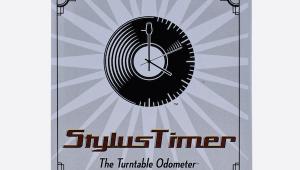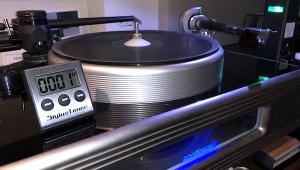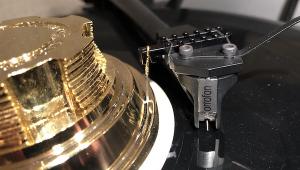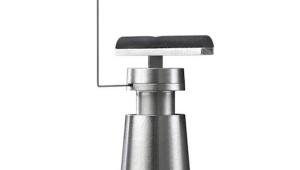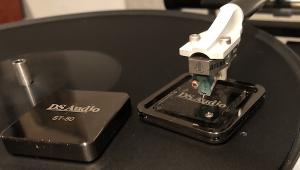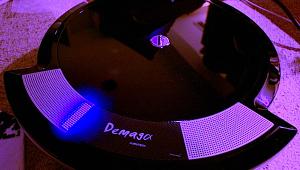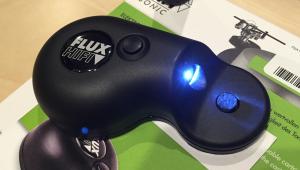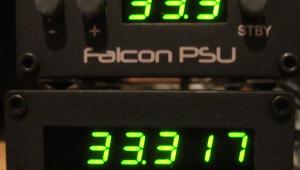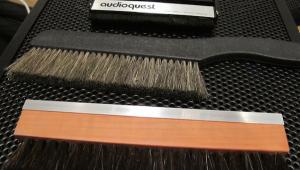DS Audio’s Truly Excellent ES 001 Eccentricity Detection Stabilizer
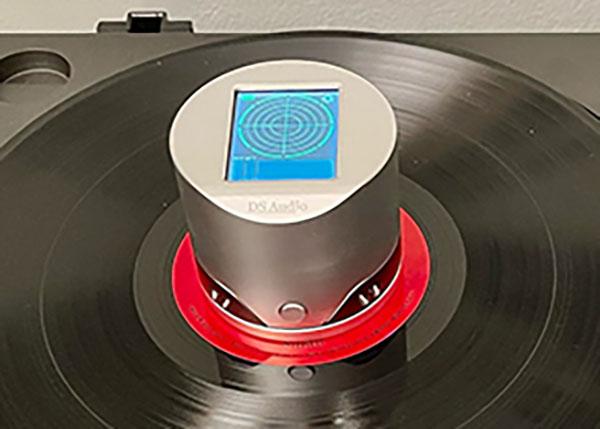
One problem that seems to plague many turntable designers is they frequently start with the assumption that the record you’re going to play on their creation is perfect — as in, it’s flat, smooth, and perfectly centered. Unfortunately, this is rarely true, as most records do have errors of one type or another.
I would argue perfect centering is far more important than having a flat record. [Agreed!—MM] Even the slightest amount of wiggling back and forth as the record spins will cause two distinct problems. For starters, as the cartridge jogs from side to side, the arm’s horizontal motion will be reversing direction every 0.9 seconds, resulting in potential stiction problems with gimbal bearings, and potential azimuth shifts with a unipivot as the stylus drags the arm to the left, and then to the right.
More importantly, an off-center record’s pitch will be constantly wavering up and down every 1.8 seconds. If, for example, you’ve ever looked at a readout from the Dr. Feickert PlatterSpeed app, you will have noticed there’s a green line that shows speed over time, and a yellow line that looks like a sine wave. The green line has been filtered by the app to make it easier to interpret, but the wiggly yellow line represents what you actually hear when you’re listening to the record.
We have solutions to help deal with a lack of flatness, of course. There are clamps, weights, rings, vacuum platters, and even record-flattening machines that can make your record as flat as a mirror, but a lack of perfectly centered records is a problem pretty much all turntable designers have chosen to ignore.
It wasn’t always this way. Forty years ago, Nakamichi offered two models that endeavored to center your records perfectly, using contraptions that would have made Rube Goldberg proud. But now, after nearly 40 years of most everyone ignoring the problem, DS Audio has introduced its solution — namely, the DS Audio ES 001 eccentricity detection stabilizer.
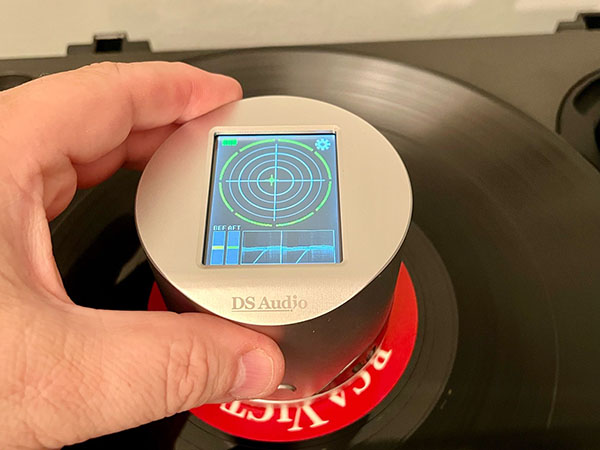
The ES 001 is an intensely clever device that uses LEDs and electronics to determine how off-center your record is, but fixing the problem isn’t always so simple. First of all, an off-center record can be the result of two things. Sometimes, it’s simply that there’s a little play between the turntable’s spindle and the hole, making it pure luck how centered the record is when you drop it onto the platter — but more often, the hole isn’t perfectly concentric with the grooves, due to imperfect positioning of the stamper in the press when the record was made. The ES 001 is perfect for fixing the first problem, though solving the second one might require more drastic measures.
The DS Audio ES 001 (which retails for $6,000) looks a bit like a fancy audiophile record weight, albeit one with a small display screen on top. It has two parts: 1) a base that sits flat on a record’s label, centered on the platter spindle by a clever self-adjusting hole, and 2) the main measuring unit and display, which can rotate freely on the base. To measure your record’s centering, you place the ES 001 on the record with the platter stopped, and then, while holding the top half of the device, you start the platter, and will next be prompted on the screen to start the measurement.
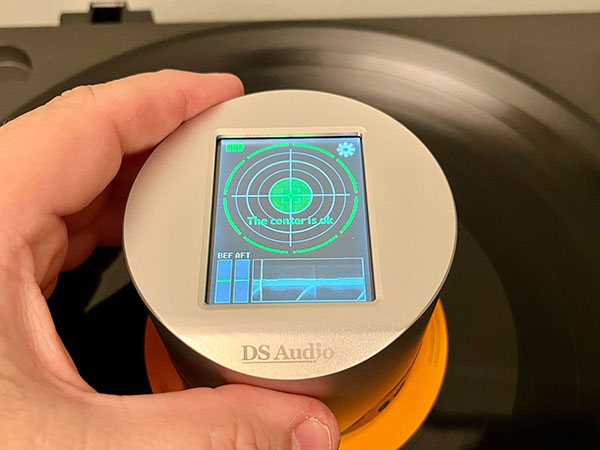
The ES 001’s optical sensors will read any movement in the position of the lead-out groove at the end of the record, then show the results as a plus sign (+) on a target in the display. You then stop the platter and nudge the record by hand to get the plus sign as close to the center of the target as possible. If you’re 100% perfect, you will be rewarded with a message saying, “The center is ok.” If not, you can repeat the test to try and refine your results. The entire process can be done in as little as 30 seconds, but that length of time may vary depending on how long your platter takes to start and stop. Once you’ve got it lined up, you can remove the ES 001 and play the record as is, or you can add a weight of your choice (more about that later).
If the record is pressed accurately and you’re only dealing with a little slop between the spindle and hole, you’re golden. But if the hole is actually a tiny bit off-center, you may have to take matters into your own hands (so to speak). Included in the kit that comes with the ES 001 is a reamer that can be used to expand the record hole a little bit, giving more scope for adjustment. Of course, doing this is non-reversible, so you’re going to have to ask yourself whether you really want to permanently alter your record so you can center it perfectly. I found, in most cases, that even when I couldn’t get a record centered to “The center is ok” standards, I was able to minimize the eccentricity without having to ream out the hole.
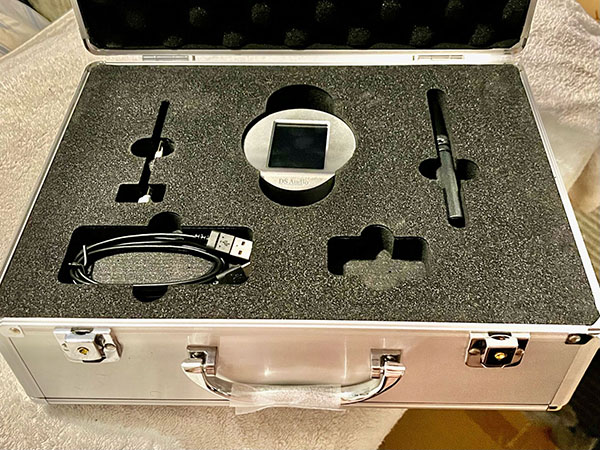
Compatibility Options
Before I got the DS Audio ES 001 review sample in hand, I figured my Roksan turntable with its removable spindle would be a perfect match for the device, with plenty of scope to move the record around on the platter as needed. As it turns out, the device needs to be perfectly centered relative to the platter, and that self-adjusting center hole doesn’t get small enough to lock down on the stub left when you take off the Roksan’s spindle. The device will still work on a Roksan or Vertere turntable, but you need to leave the removable spindle cap in place.
Turntables with record-clamping systems can be problematic when used with the ES 001. Most clamps work by placing a washer around the spindle to lift the center of the record, then the clamp flexes the record down onto the platter surface. Because the ES 001 has to sit flat on the record label to work, you will have to remove the lift washer to use it — but once the record has been centered, you have no way to put the washer back without disturbing the record’s position.
This could be a problem with many high-end turntables including SME, Kuzma, Brinkmann, AMG, VPI, and others. You can always carefully replace the ES 001 with a record weight or a simple clamp that doesn’t use a lift washer, but your elaborate clamp may not be compatible. Even with turntables like the Dr. Feickert that don’t use a lift washer, you will need to take care not to shift the record’s position as you screw the clamp into place. I used the ES 001 with my Brinkmann La Grange turntable by simply using its clamp with the lift washer removed, while taking care not to shift the record on the glass platter. (I did not have a vacuum platter turntable available at the time of this review, so I could not try the ES 001 with one of them.)
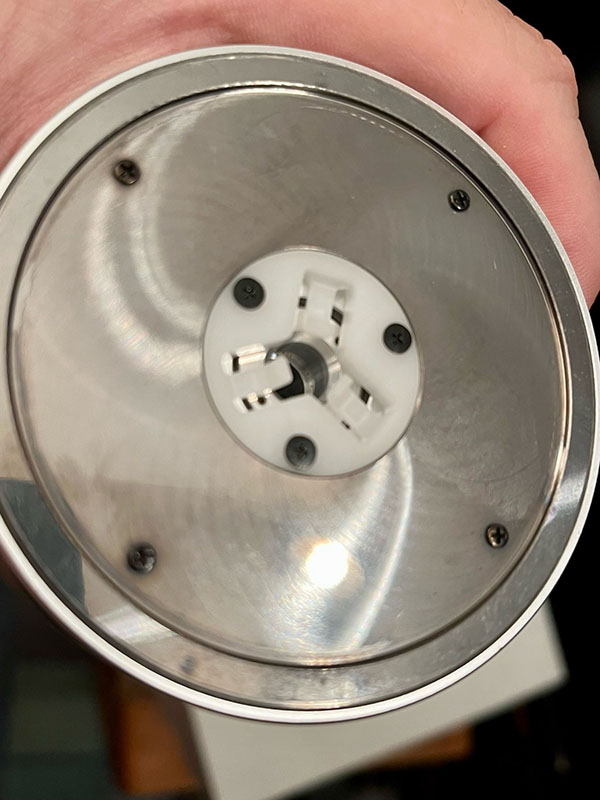
The Stabilizer Percentages
In a perfect world, the DS Audio ES 001 would have no purpose, but in reality, without correction, pretty much every record will sit on your platter a little off-center. While testing the ES 001, I went through over 100 records to see how bad they were — thankfully, very few were off by more than the center bullseye ring of the display’s target area. In most cases, I could reduce any error by at least 75%, just by manipulating the record within the play around the spindle.
This adjustment can vary a bit, depending on how tight your record spindle is. I found my Thorens TD-125 rarely left any play, while my Technics SL-1200 offered more scope. I did successfully use the reamer on a couple of particularly bad LP examples, but permanently altering my records really cuts against the grain for me. I just can’t do it.
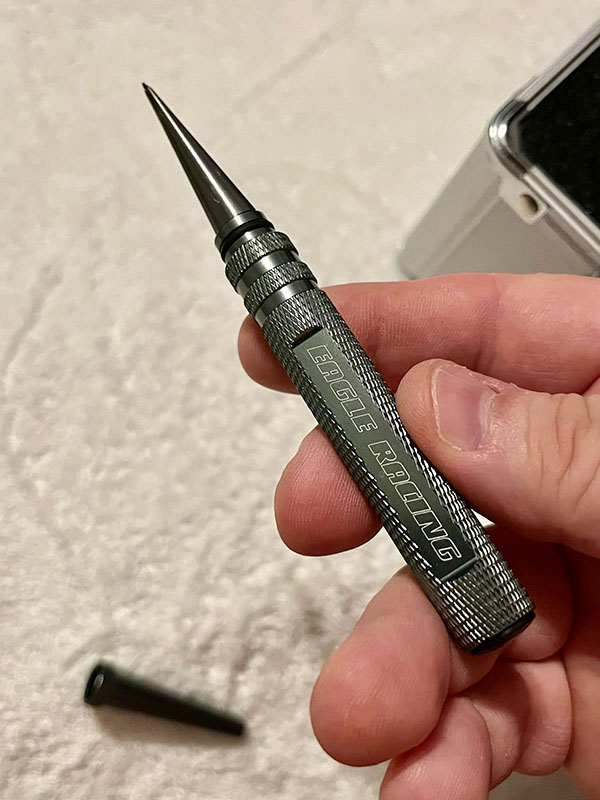
Sonically, a perfectly centered record takes on a lot of the better qualities of an open reel tape, or, dare I say it, a CD. There is a solidity and sure-footed quality that becomes addictive, with no ambiguity in the pitch of each note. This is most obvious with a pitch-stable instrument like a piano, but the effect is quite audible with most instruments. Chords sound more in tune, and harmonically complex. As Linn’s Ivor Tiefenbrun would say, it plays the tune.
Conclusion
The improvements wrought by the DS Audio ES 001 eccentricity detection stabilizer can be quite striking, and this device demonstrates how pointless it is to get too worked up about a turntable’s wow and flutter specs unless you can also address this basic issue. True, something as simple as a tapered spindle, like those used on TechDAS turntables, can go a long way towards fixing the centering problem, albeit in a much-easier-to-implement way.
Though the hurdles I’ve outlined above, plus the device’s hefty $6K price tag, will admittedly limit the ES 001’s appeal for some, I’m quite happy its mere existence will finally get people talking about this fundamental problem with LP playback. Fact is, the DS Audio ES 001 eccentricity detection stabilizer does exactly what it is designed to do. It is simple and quick to use, and it helps remedy a critical record-centering problem I’ve often wished was a bit easier to address.
For More Info
For more information about DS Audio, go here. If you want to order an ES 001, go here, and be sure to scroll down to the USA and Canada section underneath the America & South America header to find out exactly where to do so.
Author bio: Since the mid-1980s Michael Trei has worn several hats in the high-end audio world, at times serving as a retailer, installer, distributor, and writer (his byline often appears in Sound & Vision, in fact). For the last 20 years, he has also offered his services as a high-end turntable setup specialist, working on hundreds of systems a year for both customers and dealers around the globe.


